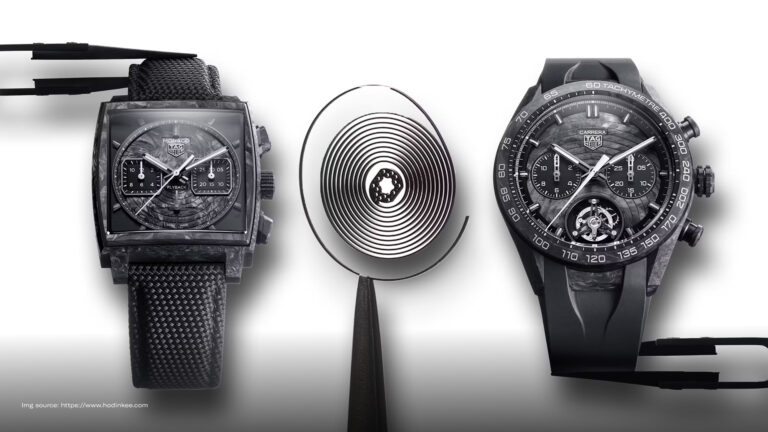Only a few brands dare to fail publicly in the conservative world of Swiss watchmaking—let alone choose to rise from that failure. TAG Heuer TH-Carbonspring is one of them: an innovation reborn from persistence and the determination to fix what once went wrong.
Table of Contents
ToggleFrom Isograph to TH-Carbonspring
The story began in 2019, when TAG Heuer introduced the Isograph technology—a carbon-composite hairspring claimed to be more precise and robust than traditional metal or silicon hairsprings. In theory, this technology could improve isochronism—the ability of a movement to maintain accuracy in different positions and temperature conditions—while also providing resistance to magnetism and shocks.
However, reality proved less ideal. The mass production of the Isograph turned out to be far more complex than initially anticipated. Minor variations in the material’s structure caused performance inconsistencies from one unit to another. TAG Heuer eventually recalled models using this technology, including the Autavia collection, and decided to put the project on hold.
Rather than erasing its traces, TAG Heuer chose a longer and more difficult path: to perfect the technology from scratch.
Six Years of Research That Changed Direction
It took six years of research and testing at the TAG Heuer Institute to produce a new version of the technology, now known as TAG Heuer TH-Carbonspring. No longer called “Isograph,” this technology represents a complete reengineering effort.
TAG Heuer TH-Carbonspring retains the same core principle, a thin spiral made of carbon composite, but with an entirely new structure and manufacturing process. Through the Chemical Vapor Deposition (CVD) method, carbon layers are formed from a gas phase to create a combination of nanotubes and amorphous carbon layers. The result is an ultra-light hairspring that is unaffected by magnetism, resistant to extreme temperatures, and has a consistent elastic modulus across all units.
The most significant difference from the Isograph generation lies in the collet formation process, a small central component of the hairspring that is usually assembled manually. In TAG Heuer TH-Carbonspring, the collet now grows directly together with the carbon spiral structure in a single production process.
This means there is no additional bonding stage that could trigger precision deviation. This step not only reduces the margin of error but also allows for a more stable and efficient production process on an industrial scale.
TAG Heuer has filed four patents protecting the manufacturing methods and new material structure. Each carbon helix is measured, tested, and calibrated to a micron-level tolerance, ensuring that every TH-Carbonspring possesses identical mechanical properties.
Precision That Can Be Measured
In internal testing, TAG Heuer TH-Carbonspring demonstrated significantly improved performance compared to traditional metal hairsprings. Its carbon material has a near-zero thermal expansion coefficient, maintaining spiral stability even under extreme temperature changes.
Additionally, the material’s density—much lower than that of steel—reduces the inertia of the oscillating system, meaning the balance wheel moves more efficiently and timekeeping precision is better preserved.
Shock resistance has also improved dramatically. In simulated impacts equivalent to 5000G—comparable to shocks that could destroy conventional metal hairsprings—the TH-Carbonspring maintained oscillation amplitude without permanent deformation.
Meanwhile, its resistance to magnetic fields keeps time deviation caused by external magnet exposure nearly zero, a crucial achievement in today’s world filled with electronic devices.
An Innovation That Sets It Apart
Many Swiss manufactures have turned to silicon hairsprings for their anti-magnetic properties, but TAG Heuer took a different path. With TAG Heuer TH-Carbonspring, the brand developed a material that not only rivals silicon but also overcomes its weaknesses.
Unlike silicon, which is brittle and difficult to repair, TAG Heuer’s carbon hairspring offers a unique combination of structural strength, flexibility, and consistent performance. More than just a technical innovation, TH-Carbonspring reinforces TAG Heuer’s independence and no longer relies on external suppliers for one of the most critical components of its movements.
TAG Heuer TH-Carbonspring is not merely a successful research project. It symbolizes how this 160-year-old brand continues to uphold its spirit of innovation. What was once known as the “Isograph” has now been reborn as the “TH-Carbonspring”, with a more mature scientific foundation, a precisely controlled production process, and performance that can truly be proven.














